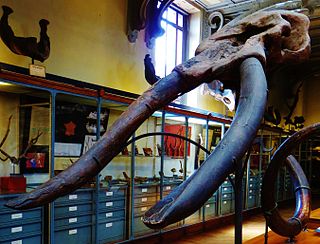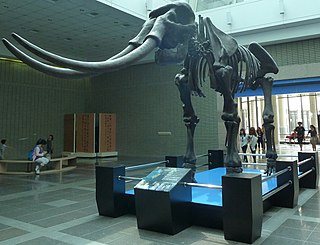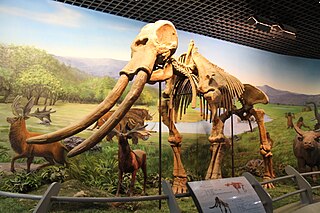 W
WAnancus is an extinct genus of elephantoid proboscidean native to Afro-Eurasia, that lived from the Tortonian stage of the late Miocene until the genus' extinction during the early Pleistocene, roughly from 8.5–2 million years ago.
 W
WThe pygmy mammoth or Channel Islands mammoth is an extinct species of dwarf elephant descended from the Columbian mammoth of mainland North America. This species became extinct during the Quaternary extinction event in which many megafauna species became extinct due to changing conditions to which the species could not adapt. A case of island or insular dwarfism, from a recent analysis in 2010 it was determined that M. exilis was on average, 1.72 m (5.6 ft) tall at the shoulders and 760 kg (1,680 lb) in weight, in stark contrast to its 4.3 m (14 ft) tall, 9,070 kg (20,000 lb) ancestor. Another estimate gives a shoulder height of 2.02 m (6.6 ft) and a weight of 1,350 kg (2,980 lb).
 W
WThe Columbian mammoth is an extinct species of mammoth that inhabited the Americas as far north as the Northern United States and as far south as Costa Rica during the Pleistocene epoch. It was one of the last in a line of mammoth species, beginning with Mammuthus subplanifrons in the early Pliocene. DNA studies show that the Columbian mammoth was a hybrid species between woolly mammoths and another lineage descended from steppe mammoths; the hybridization happened more than 420,000 years ago. The pygmy mammoths of the Channel Islands of California evolved from Columbian mammoths. The closest extant relative of the Columbian and other mammoths is the Asian elephant.
 W
WCuvieronius is an extinct New World genus of gomphothere, named after the French naturalist Georges Cuvier. Alive, specimens typically stood about 2.3 m tall at the shoulder, weighed about 3.5 t and would have superficially resembled a modern elephant with spiral-shaped tusks.
 W
WDeinotherium was a large prehistoric relative of modern-day elephants that appeared in the Middle Miocene and survived until the Early Pleistocene. During that time, it changed very little. In life, it probably resembled modern elephants, except it had downward-curving tusks attached to the lower jaw.
 W
WElephas hysudricus is an extinct elephant species and was described from fossil remains found in the Siwalik hills. It lived during the Pliocene and Pleistocene epochs.
 W
WGomphotheres are any members of the diverse, extinct taxonomic family Gomphotheriidae. Gomphotheres were elephant-like proboscideans, but not belonging to the family Elephantidae. They were widespread in across Afro-Eurasia and North America during the Miocene and Pliocene epochs and dispersed into South America during the Pleistocene following the Great American Interchange. Gomphotheriidae in its broadest sense is probably paraphyletic with respect to Elephantidae, which contains modern elephants. While most famous forms such as Gomphotherium had long lower jaws with tusks, which is the ancestral condition for the group, after these forms became extinct, the surviving gomphotheres had short jaws with either vestigal or no lower tusks (brevirostrine), looking very similar to modern elephants, an example of parallel evolution. During the Pleistocene epoch, most gomphotheres became extinct, with the last two genera, Cuvieronius persisting in southern North America and Notiomastodon having a wide range over most of South America until the end of the Pleistocene and human arrival in the Americas around 11,000 years ago.
 W
WThe Island 35 Mastodon was discovered on Island No. 35 of the Mississippi River in Tipton County, Tennessee, United States.
 W
WLoxodonta atlantica is an extinct species of elephant in the genus Loxodonta, from Africa. It was larger than the modern African elephant, with more progressive dentition. It includes Pleistocene fossils from Ternifine, Middle Pleistocene fossils from Elandsfontein and Late Pliocene fossils from the Omo River, with a final dating in the Late Pleistocene. L. atlantica was said to probably derive from L. adaurora; however, an analysis in 2009 suggested that L. atlantica evolved from L. exoptata, and is ancestral to L. africana. The species is divided into two subspecies: L. atlantica atlantica and L. atlantica zulu. The type for Loxodonta atlantica is housed in the Muséum national d'histoire naturelle in Paris, but is listed without a specimen number.
 W
WLyuba is a female woolly mammoth calf who died c. 41,800 years ago at the age of 30 to 35 days. She was formerly the best preserved mammoth mummy in the world, surpassing Dima, a male mammoth calf mummy which had previously been the best known specimen.
 W
WA mammoth is any species of the extinct elephantid genus Mammuthus, one of the many genera that make up the order of trunked mammals called proboscideans. The various species of mammoth were commonly equipped with long, curved tusks and, in northern species, a covering of long hair. They lived from the Pliocene epoch into the Holocene at about 4,000 years ago, and various species existed in Africa, Europe, Asia, and North America. They were members of the family Elephantidae, which also contains the two genera of modern elephants and their ancestors. Mammoths are more closely related to living Asian elephants than African Elephants.
 W
WThe pygmy mammoth or Channel Islands mammoth is an extinct species of dwarf elephant descended from the Columbian mammoth of mainland North America. This species became extinct during the Quaternary extinction event in which many megafauna species became extinct due to changing conditions to which the species could not adapt. A case of island or insular dwarfism, from a recent analysis in 2010 it was determined that M. exilis was on average, 1.72 m (5.6 ft) tall at the shoulders and 760 kg (1,680 lb) in weight, in stark contrast to its 4.3 m (14 ft) tall, 9,070 kg (20,000 lb) ancestor. Another estimate gives a shoulder height of 2.02 m (6.6 ft) and a weight of 1,350 kg (2,980 lb).
 W
WMammuthus meridionalis, or the southern mammoth, is an extinct species of mammoth native to Europe and Central Asia from the Gelasian stage of the Early Pleistocene, living from 2.5–0.8 mya.
 W
WA mastodon is any proboscidean belonging to the extinct genus Mammut that inhabited North and Central America during the late Miocene or late Pliocene up to their extinction at the end of the Pleistocene 10,000 to 11,000 years ago. Mastodons lived in herds and were predominantly forest-dwelling animals. They survived on a mixed diet and obtained food by browsing and grazing, somewhat similar to modern elephants, but probably with greater emphasis on browsing
 W
WThis list of museums and colleges includes locations exhibiting mastodon fossils.
 W
WNotiomastodon is an extinct proboscidean genus of gomphotheres endemic to South America from the Pleistocene to the Holocene. It was among the last known gomphotheres and one of two South American gomphotheres alongside Cuvieronius, and was the predominant gomphothere on the continent ranging widely over most of South America excluding the high Andes. The species has a long and convoluted taxonomic history due to its morphological variability and confusion with related gomphothere taxa, which was only resolved during the 2010s.
 W
WPalaeoloxodon is an extinct genus that contains the various species of straight-tusked elephants. The genus originated in Africa during the Pliocene era, and expanded into Eurasia during the Pleistocene era. One species, Palaeoloxodon namadicus, was possibly the largest known land mammal. The genus has a long and complex taxonomic history, and at various times, it has been considered to belong to Loxodonta or Elephas, but today is considered distinct.
 W
WPalaeoloxodon cypriotes, the Cyprus dwarf elephant, is an extinct species that inhabited the island of Cyprus during the Late Pleistocene until around 11,000 years BC. Remains comprise 44 molars, found in the north of the island, seven molars discovered in the south-east, a single measurable femur and a single tusk among very sparse additional bone and tusk fragments. The molars support derivation from the straight-tusked elephant (Palaeoloxodon antiquus), that inhabited Europe since 780,000 years ago. The species is presumably derived from the older, larger P. xylophagou from the late Middle Pleistocene which reached the island presumably during a Pleistocene glacial maximum when low sea levels allowed a low probability sea crossing between Cyprus and Asia Minor, most likely between the Karpas peninsula and Adana Province. During subsequent periods of isolation the population adapted within the evolutionary mechanisms of insular dwarfism, which the available sequence of molar fossils confirms to a certain extent. The fully developed Palaeoloxodon cypriotes weighed not more than 200 kg (440 lb) and had a maximum height of 1.40 m (4.59 ft). Whether the species extinction is to be attributed to the arrival of humans on the island remains debated. The species represented a sizable food source, but was easily overcome by contemporary hunter-gatherer populations. An association of dwarf elephant bones with human artefacts is found at the ~13,000 to 11,000 year old Aetokremnos site on the southern coast of the island.
 W
WPalaeoloxodon falconeri, also known as the pygmy elephant, Maltese pygmy elephant, or Sicilian dwarf elephant, is an extinct Siculo-Maltese species of elephant that was derived from the straight-tusked elephant.
 W
WPalaeoloxodon mnaidriensis or Elephas mnaidriensis is an extinct species of elephant from Malta and Sicily closely related to the modern Asian elephant, or possibly to the modern African forest elephant. This elephant is a separate species with respect to the European mainland straight-tusked elephant and not just a smaller insular form. P. mnaidriensis has nearly 90% body reduction compared to the ancestral form with an estimated shoulder height of about 1.8 metres (5.9 ft) and a mean body weight of about 1,100 kilograms (2,400 lb). Another estimate gives a shoulder height of 2 m (6.6 ft) and a weight of 1.7 t.
 W
WPalaeoloxodon namadicus or the Asian straight-tusked elephant, was a species of prehistoric elephant that ranged throughout Pleistocene Asia, from India to Japan.
 W
WPalaeoloxodon naumanni, occasionally called Naumann's elephant, is an extinct species belonging to the genus Palaeoloxodon found in the Japanese archipelago during the Middle to Late Pleistocene around 430,000 to 24,000 years ago. It is named after Heinrich Edmund Naumann who discovered the first fossils at Yokosuka, Kanagawa, Japan. Fossils attributed to P. naumanni are also known from China.
 W
WPalaeoloxodon recki is an extinct species of elephant native to Africa during the Pliocene and Pleistocene. At up to 14 feet in shoulder height, it was one of the largest elephant species to have ever lived. It is believed that P. recki ranged throughout Africa between 3.5 and 1 million years ago. P. recki was a successful grass-eating elephant until it became extinct, perhaps by competition with members of the genus Loxodonta, the African elephants of today. Its descendant taxon, "Elephas" jolensis persisted into the late Middle Pleistocene, c. 205-130 kya in Kenya, after which it was replaced by Loxodonta africana after a severe drought period. P. recki is believed to be the ancestral species from which the Palaeoloxodon species of Eurasia are derived.
 W
WThe pygmy mammoth or Channel Islands mammoth is an extinct species of dwarf elephant descended from the Columbian mammoth of mainland North America. This species became extinct during the Quaternary extinction event in which many megafauna species became extinct due to changing conditions to which the species could not adapt. A case of island or insular dwarfism, from a recent analysis in 2010 it was determined that M. exilis was on average, 1.72 m (5.6 ft) tall at the shoulders and 760 kg (1,680 lb) in weight, in stark contrast to its 4.3 m (14 ft) tall, 9,070 kg (20,000 lb) ancestor. Another estimate gives a shoulder height of 2.02 m (6.6 ft) and a weight of 1,350 kg (2,980 lb).
 W
WSinomastodon is an extinct gomphothere genus, from the Late Miocene to the Early Pleistocene deposits of Asia. It is not to be confused with the genus Mammut from a different proboscidean family, whose members are commonly called "mastodons".
 W
WStegodon, meaning "roofed tooth" because of the distinctive ridges on the animal's molars, is a genus of the extinct subfamily Stegodontinae of the order Proboscidea. It was assigned to the family Elephantidae, but has also been placed in the Stegodontidae. Stegodonts were present from 11.6 million years ago (Mya) to the late Pleistocene, with unconfirmed records of localized survival until 4,100 years ago. Fossils are found in Asian and African strata dating from the late Miocene; during the Pleistocene, they lived across large parts of Asia and East and Central Africa, and in Wallacea as far east as Timor.
 W
WStegomastodon is an extinct genus of gomphotheres, a family of proboscideans. It ranged throughout North America from the early Blancan ~4 Ma, to the early Irvingtonian. The South American species have been synonymized with Notiomastodon platensis.
 W
WThe steppe mammoth is an extinct species of Elephantidae that ranged over most of northern Eurasia during the late Early and Middle Pleistocene, approximately 1.8 million-200,000 years ago. It evolved in Siberia during the Early Pleistocene from Mammuthus meridionalis. It was the first stage in the evolution of the steppe and tundra elephants and the ancestor of the woolly mammoth and Columbian mammoth of the later Pleistocene. Populations of steppe mammoth may have persisted in northern China and Mongolia as recently as 33,000 years ago.
 W
WThe straight-tusked elephant is an extinct species of elephant that inhabited Europe and Western Asia during the Middle and Late Pleistocene. Recovered individuals have reached up to 4–4.2 metres (13.1–13.8 ft) in height, and an estimated 11.3–15 tonnes in weight. The straight-tusked elephant probably lived in small herds, flourishing in interglacial periods, when its range would extend as far as Great Britain. Isolated tusks are often found while partial or whole skeletons are rare, and there is evidence of predation by early humans. It is the ancestral species of most dwarf elephants that inhabited islands in the Mediterranean.
 W
WThe woolly mammoth is a species of mammoth that lived during the Pleistocene until its extinction in the Holocene epoch. It was one of the last in a line of mammoth species, beginning with Mammuthus subplanifrons in the early Pliocene. The woolly mammoth began to diverge from the steppe mammoth about 800,000 years ago in East Asia. Its closest extant relative is the Asian elephant. DNA studies show that the Columbian mammoth was a hybrid between woolly mammoths and another lineage descended from steppe mammoths. The appearance and behaviour of this species are among the best studied of any prehistoric animal because of the discovery of frozen carcasses in Siberia and Alaska, as well as skeletons, teeth, stomach contents, dung, and depiction from life in prehistoric cave paintings. Mammoth remains had long been known in Asia before they became known to Europeans in the 17th century. The origin of these remains was long a matter of debate, and often explained as being remains of legendary creatures. The mammoth was identified as an extinct species of elephant by Georges Cuvier in 1796.
 W
WYuka is the best-preserved woolly mammoth carcass ever found. It was discovered by local Siberian tusk hunters in 2010. They turned it over to local scientists, who made an initial assessment of the carcass in 2012. It is displayed in Moscow.